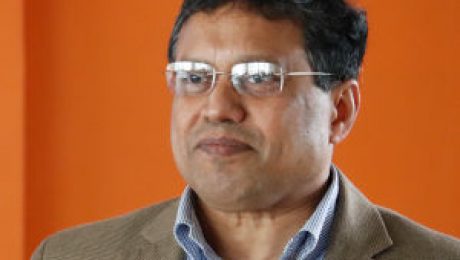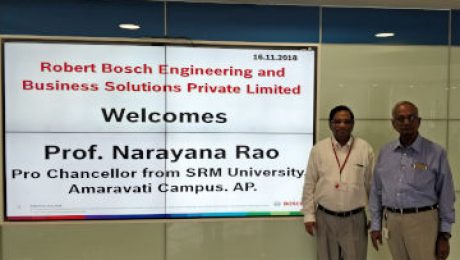Teacher-Student Duo Author a Chapter on Graph Neural Networks
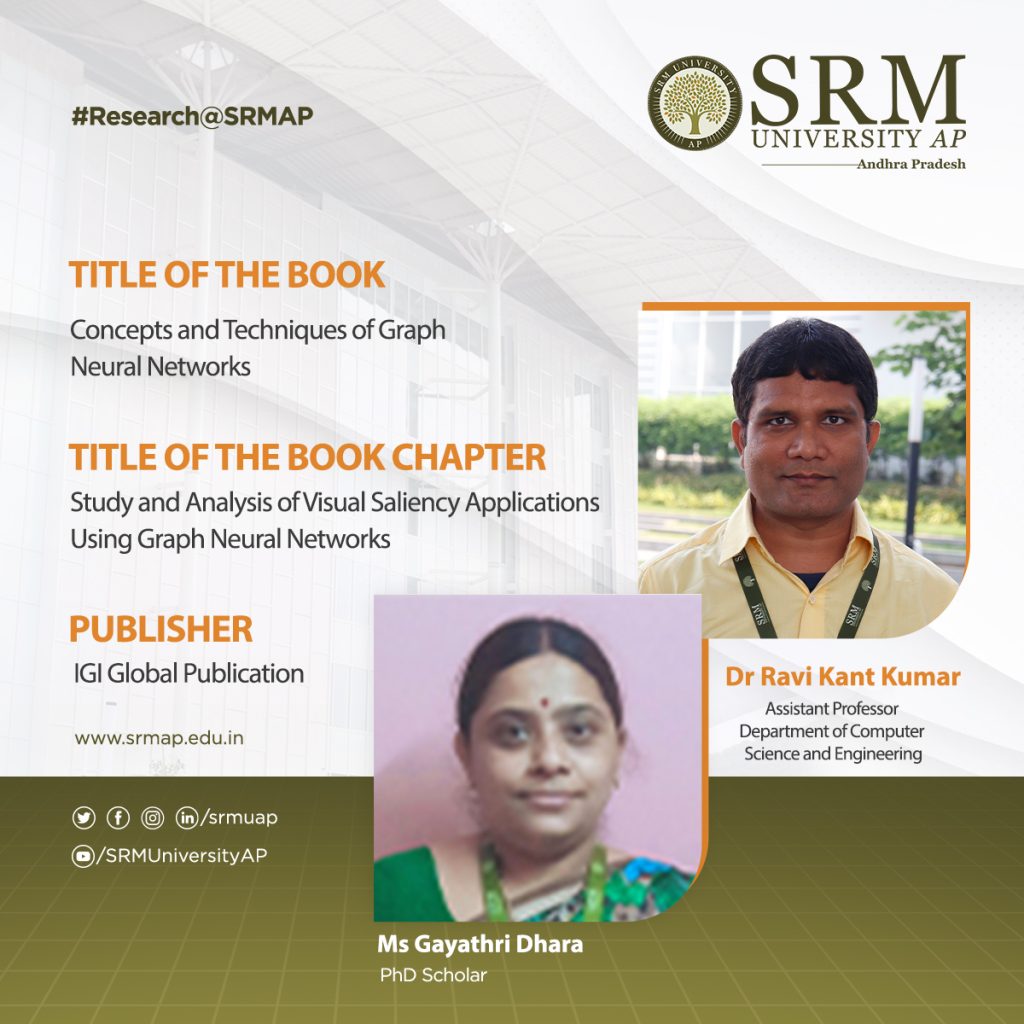
Dr Ravi Kant Kumar, Assistant Professor at the Department of Computer Science and Engineering at SRM University-AP and his research scholar, Ms Gayathri Dhara have recently made a significant contribution to the field of Graph Neural Networks. The teacher-student duo have offered relevant analysis of visual saliency applications using Graph Neural Networks (GNN) in their book chapter titled “Study and Analysis of Visual Saliency Applications Using Graph Neural Networks” in the book, Concepts and Techniques of Graph Neural Networks. The topic of their study will prove to be a key source of reference for industry professionals, researchers, scholars, academicians, practitioners, instructors, and students.
Description and Significance of the Chapter
The chapter covers the practical applications of GNN in the field of visual saliency. Various applications of computer vision problems implemented using graph neural networks (GNNs) have been studied and analysed in this chapter. It also includes the design approach of GNN, the various computational models used in GNN, its challenges and recommendations. The social significance of GNN in visual saliency extends to various domains like Human attention modelling, Advertising and marketing, Visual content understanding, and so on.
Significance of GNNs
Graph Neural Networks (GNNs) have gained significance in the field of visual saliency due to their ability to model complex relationships and dependencies within visual data. Visual saliency refers to the process of predicting the most visually prominent regions or areas in an image or video that attract human attention. It plays a crucial role in various computer vision applications, such as image understanding, object recognition, and scene understanding. GNNs can learn spatial dependencies and feature representations from visual data. There are many methodologies that address the detection of the salient object using GNN. GNNs can handle multi-modal data, combining visual information with other modalities such as textual or semantic features. This integration allows GNNs to leverage additional cues and contextual information to improve visual saliency prediction. So, studying these different salient object detection methods using GNN and knowing the challenges of GNN will help in meeting our research objectives.
- Published in CSE NEWS, Departmental News, News, Research News
Biological Science Researcher bags DST INSPIRE Fellowship
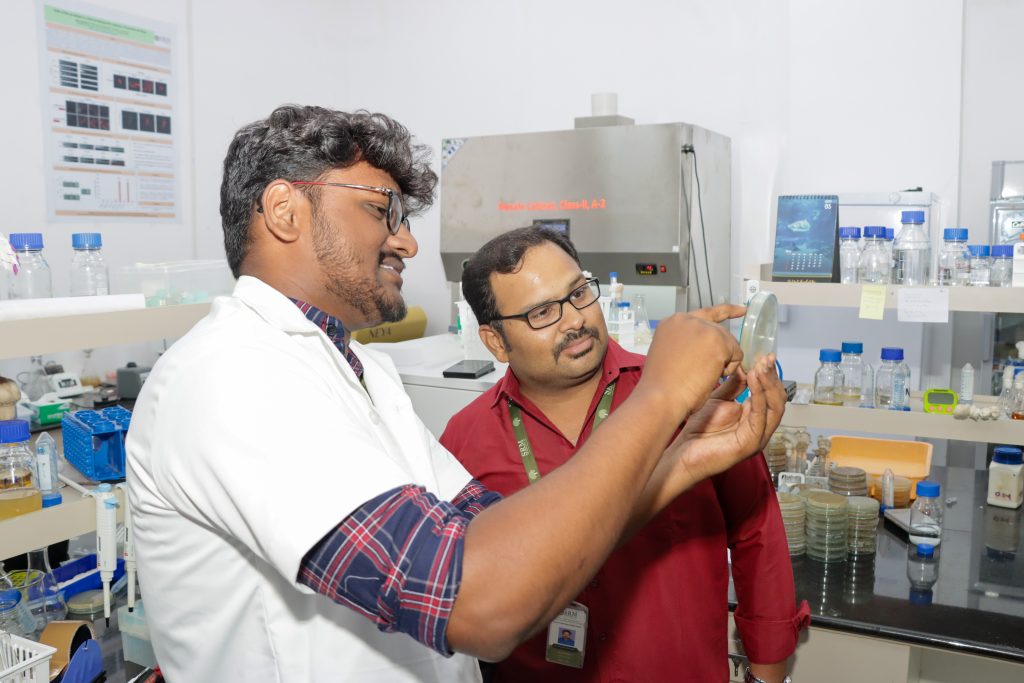
Barath Sivaraj, a research scholar from the Department of Biological Sciences at SRM University-AP has achieved an outstanding feat by receiving the DST INSPIRE Fellowship, a highly regarded programme sponsored and overseen by the Department of Science & Technology.
Sivaraj’s research focuses on exploring how bacteriophages, a type of virus that infects and reproduces inside bacteria, utilises the bacterial system. This research has earned Sivaraj the Fellowship, which runs for a duration of 5 years. The researcher also gets to carry out his research at any national or international laboratories other than their host institute for a period of 18 months.
Barath expresses his immense delight and pride in receiving this fellowship and considers it a significant milestone in his academic journey. Sivaraj explains that applicants must meet several criteria, such as being a top-ranked student in a full-time postgraduate science programme or a related field at the university level. Sivaraj credits his research supervisor, Dr Sutharsan Govindarajan, for guiding him through the application process. As a future prospect, Sivaraj plans to pursue his post-doctoral studies abroad and eventually wishes to offer his professional services at a reputable university.
We wish him all success!
- Published in Biology News, Departmental News, News, Research News
SRM AP Professor Swaminathan in joint observational study on US Medicaid effect on Renal Disease patients.
For a study published in JAMA (Journal of the American Medical Association – Impact factor – 47.661), SRM AP Associate Dean of SLABS, Professor Shailender Swaminathan, and US based colleagues (Benjamin D. Sommers, Rebecca Thorsness, Rajnish Mehrotra, Yoojin Lee, and Amal N. Trivedi) used a U.S.national registry to identify patients 19-64 with newly developed end stage renal disease who had initiated dialysis in a 6 year period 2011-2017.
- Published in Research News
“Research is a culture, adopted through practice.” Professor Prasant Mohapatra
“Problems in the world are not discipline specific. Universities need a wider scope in research,” was one of the points raised by Prasant Mohapatra, member of SRM AP Board of Governors, in his symposium on research methodologies. “Research responds to societal needs. To remain contemporary and dynamic it is necessary to reinforce it regularly with current best practices.”
- Published in Research News
SRM AP Pro Vice Chancellor Dr. D. Narayana Rao and BOSCH to establish Bosch-SRM Research Centre for Artificial Intelligence in health care
The Robert Bosch Engineering and Business Solutions Pv.t Ltd in Bangalore along with SRM AP will set up a centre at SRM Amaravati to carry out research in Artificial Intelligence for health care. SRM AP Pro Vice Chancellor Dr. D. Narayana Rao and BOSCH Bangalore have been in discussions on this initiative that will bring together researchers from SRM AP’s engineering program and Bosch, a leading supplier of technology and services in mobility solutions, industrial technology and energy.
- Published in News, Research News
SRM AP’s new cell culture facility to pioneer bio-medical research

Dr. Anil K. Suresh, Principal Investigator, Associate Professor, Biological Sciences with SRM AP Pro VC Prof. Narayana Rao
A newly established research facility in the main academic block will house advanced equipment for research related to applications like cellular culture, drug delivery, cell imagingand cell cytotoxicity. Dr. Anil K. Suresh, Principal Investigator of the cell culture laboratory who is currently an Associate Professor at the department of Biological Sciences spearheaded the acquisition of lab equipment such as the Type 2 biosafety cabinet, CO2 incubators, cell counting machine, inverted and upright microscopes, table-top centrifuge, – 20 and 4 degree refrigerators and cell storage facility.
- Published in News, Research News
University of Texas at Arlington and SRM AP propose research collaboration and student exchange programs.
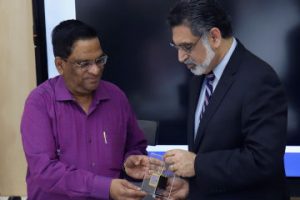
SRM AP Pro VC Prof. Narayana Rao presenting memento to UTI President, Vistasp Karbhari
December 03, 2018: In a joint discussion presided by SRM AP Pro VC Prof. Narayana Rao, Registrar D. Gunasekaran, SRM AP faculty and staff, Pranesh Aswath, UTI Vice Provost for Academic Planning and Policy, UTI President Karbhari spoke of how, in face of global changes in education and workforce demands, education must adapt in modality with a flexible and adaptive curriculum. Karbhari explained the strides UTI has made in these critical areas.
- Published in News, Research News
“Nation building requires ground-breaking research.” DRDO Chairman, Dr. G. Satheesh Reddy
In a meeting with SRM AP faculty, Dr. G. Satheesh Reddy drew attention to the prestigious ‘Make in India’ initiative, called for research on futuristic technologies for the nations benefit, and encouraged SRM AP to emerge as a hub for new technology development. Dr. G. Satheesh Reddy is eminently qualified to speak of matters like aligning future university led research objectives with national priorities. He holds four key national government portfolios; He is Secretary to the Government of India in the department of Defence R&D; Chairman, Defence Research Development Organisation (DRDO); Director General, Aeronautical Development Agency (ADA) and Scientific Advisor to the Defence Minister (RM).
- Published in News, Research News
The growing impact of Nanotechnology on educational research and future markets
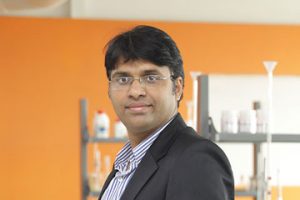 Nanomaterials are an increasingly important product of nanotechnologies with applications in medicine/healthcare, electronics, environmental health, technology and industry.
Nanomaterials are an increasingly important product of nanotechnologies with applications in medicine/healthcare, electronics, environmental health, technology and industry.
“The reason so many disciplines like chemistry, physics, engineering and biology are looking at this field is the exciting properties of materials at a nanoscale. It has broad application potential including bio-imaging diagnosis in the health sector.” says Dr. Nimai Mishra, Associate Professor of Chemistry at SRM AP.
Through his own research, Dr. Mishra, has attempted to develop a synthesis technique that can produce blinking free semi-conductor nanoparticles for increased energy savings in the use of light emitting diodes (LED), lasers and solar cells.
“For the past decade there has been considerable work in this field and in 2013 as a post-doctoral fellow at Los Alamos Lab in the U.S. I began to focus exclusively on this research.”
In April 2019, at the 2nd Global Outreach Research and Education Summit held at HITEX Exhibition Centre in Hyderabad Dr. Nimai Mishra’s work in nanomaterials was recognized with the “Young Researcher in Chemistry” award – an initiative of the Global Outreach Research & Education Association (GOREA).
Dr. Mishra, delivered a talk on “Nanochemistry: Impact in Device Fabrication” specifically, the control synthesis of nanoparticles via colloidal chemical route and their application in solar cell and LEDs.
For Dr. Mishra, whose education and research background includes IIT-Madras, NUS, Singapore, Los Alamos National Lab, USA and IIT-Genova, Italy, the summit was an opportunity to share ideas on how to meet challenges in higher education research.
At the summit, attended by over 100 delegates from all over the world, the papers presented were a diverse mix of subjects from materials science, digital dentistry, blockchain technology and the booming smart classroom market in India.
The Global Outreach Research & Education Association (GOREA) is a charitable foundation established in 2018 to promote technical advancement, entrepreneurship and skill development. GOREA achieves this through a global association of educationists, technologists, industrialists, business leaders and policymakers working towards the growth of research & education industry.
Earlier in February at IIT-BHU in Varanasi Dr. Mishra was awarded the Young Scientist Award” at the International Conference of Functional Nanomaterials (ICFNM-2019)” organized by IIT-BHU along with IIT-Guwahati and Society of Interdisciplinary Research in Material and Biology (SIRMB). The shortlisted six candidates were faculty from IIT, NIT, DBT Institute.
Of the event, Dr. Mishra said, “Speakers were from IIT, IISER and IISc. The good news is that most were aware of and admire the broad ambitious vision of the SRM AP university management.”
- Published in News, Research News
Dr. Nimai Mishra’s work in Nanomaterials recognized by leading education research institutes.
 In April 2019, at the 2nd Global Outreach Research and Education Summit held at HITEX Exhibition Centre in Hyderabad Dr. Nimai Mishra’s pioneering work in nanomaterials was recognized with the “Young Researcher in Chemistry” award, an initiative of the Global Outreach Research & Education Association (GOREA).
In April 2019, at the 2nd Global Outreach Research and Education Summit held at HITEX Exhibition Centre in Hyderabad Dr. Nimai Mishra’s pioneering work in nanomaterials was recognized with the “Young Researcher in Chemistry” award, an initiative of the Global Outreach Research & Education Association (GOREA).
At the summit, attended by over 100 delegates from all over the world, Dr. Mishra, delivered a talk on “Nanochemistry: Impact in Device Fabrication” specifically, the control synthesis of nanoparticles via colloidal chemical route and their application in solar cell and LEDs.
Through his research, Dr. Mishra, Associate Professor of Chemistry at SRM AP, has attempted to develop a synthesis technique that can produce blinking free semi-conductor nanoparticles for increased energy savings in the use of light emitting diodes (LED), lasers and solar cells.
“For the past decade there has been considerable work in this field and in 2013 as a post-doctoral fellow at Los Alamos Lab in the US I began to focus exclusively on this research. The technology has wide application potential including bio-imaging diagnosis in the health sector.”
For Dr. Mishra, whose education and research background includes IIT-Madras, NUS, Singapore, Los Alamos National Lab, USA and IIT-Genova, Italy, the summit was an opportunity to share ideas on how to meet challenges in higher education research.
The papers presented at the summit were a diverse mix of subjects from materials science, digital dentistry, blockchain technology and the booming smart classroom market in India.
The Global Outreach Research & Education Association (GOREA) is a charitable foundation established in 2018 to promote technical advancement, entrepreneurship and skill development. GOREA achieves this through a global association of educationists, technologists, industrialists, business leaders and policymakers working towards the growth of research & education industry.
Earlier in February at IIT-BHU in Varanasi Dr. Mishra was awarded the Young Scientist Award” at the International Conference of Functional Nanomaterials (ICFNM-2019)” organized by IIT-BHU along with IIT-Guwahati and Society of Interdisciplinary Research in Material and Biology (SIRMB). The shortlisted six candidates were faculty from IIT, NIT, DBT Institute.
Of the event, Dr. Mishra said, “Speakers were from IIT, IISER and IISc. The good news is that most were aware of the work being done at SRM AP and admire the broad ambitious vision of the university management.”
- Published in News, Research News



